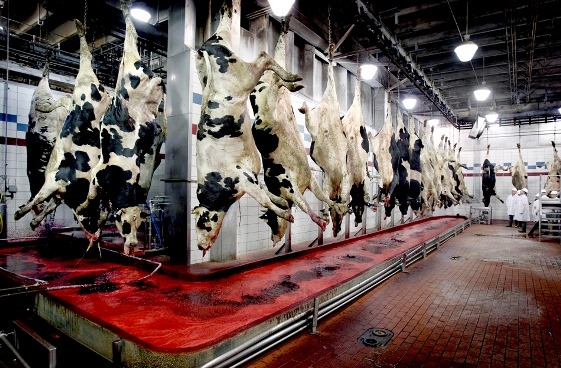By Nicholas Kristof, The New York Times, March 12, 2014
Where does our food come from? Often the answer is Tyson Foods, America’s meat factory.
Tyson, one of the nation’s 100 biggest companies, slaughters 135,000 head of cattle a week, along with 391,000 hogs and an astonishing 41 million chickens. Nearly all Americans regularly eat Tyson meat — at home, at McDonalds, at a cafeteria, at a nursing home.
“Even if Tyson did not produce a given piece of meat, the consumer is really only picking between different versions of the same commoditized beef, chicken, and pork that is produced through a system Tyson pioneered,” says Christopher Leonard, a longtime agribusiness journalist, in his new book about Tyson called “The Meat Racket.”
Leonard’s book argues that a handful of companies, led by Tyson, control our meat industry in ways that raise concerns about the impact on animals and humans alike, while tearing at the fabric of rural America. Many chicken farmers don’t even own the chickens they raise or know what’s in the feed. They just raise the poultry on contract for Tyson, and many struggle to make a living.
Concerned by the meat oligopoly’s dominance of rural America, President Obama undertook a push beginning in 2010 to strengthen antitrust oversight of the meat industry and make it easier for farmers to sue meatpackers. The aim was grand: to create a “new rural economy” to empower individual farmers.
Big Meat’s lobbyists used its friends in Congress to crush the Obama administration’s regulatory effort, which collapsed in “spectacular failure,” Leonard writes.
Factory farming has plenty of devastating consequences, but it’s only fair to acknowledge that it has benefited our pocketbooks. When President Herbert Hoover dreamed of putting “a chicken in every pot,” chicken was a luxury dish more expensive than beef. In 1930, whole dressed chicken retailed for $6.48 a pound in today’s currency, according to the National Chicken Council. By last year, partly because of Tyson, chicken retailed for an average price of $1.57 per pound — much less than beef.
Costs came down partly because scientific breeding reduced the length of time needed to raise a chicken to slaughter by more than half since 1925, even as a chicken’s weight doubled. The amount of feed required to produce a pound of chicken has also dropped sharply.
And yet.
This industrial agriculture system also has imposed enormous costs of three kinds.
First, it has been a catastrophe for animals. Chickens are bred to grow huge breasts so that as adults they topple forward and can barely breathe or stand.
“These birds are essentially bred to suffer,” says Laurie Beacham of the American Society for the Prevention of Cruelty to Animals, which argues that there’s an inherent cruelty in raising these “exploding chickens.”
Poultry Science journal has calculated that if humans grew at the same rate as modern chickens, a human by the age of two months would weigh 660 pounds.
Second, factory farming endangers our health. Robert Martin of the Johns Hopkins Bloomberg School of Public Health notes that a farm with 10,000 hogs produces as much fecal waste as a small city with 40,000 people, but the hog operation won’t have a waste treatment plant. Indeed, the hogs in a single county in North Carolina produce half as much waste as all the people in New York City, Martin says.
Leonard writes in his book that in 68 percent of the counties where Tyson operates, per capita income has grown more slowly over the last four decades than the average in that state. We may think of rural America as a halcyon pastoral of red barns and the Waltons, but today it’s also a land of unemployment, poverty, despair and methamphetamines.
It’s easy to criticize the current model of industrial agriculture, far harder to outline a viable alternative. Going back to the rural structure represented by the inefficient family farm on which I grew up in Oregon isn’t a solution; then we’d be back to $6.48-a-pound chicken.
But a starting point is to recognize bluntly that our industrial food system is unhealthy. It privatizes gains but socializes the health and environmental costs. It rewards shareholders — Tyson’s stock price has quadrupled since early 2009 — but can be ghastly for the animals and humans it touches. Industrial meat has an acrid aftertaste.

No comments:
Post a Comment